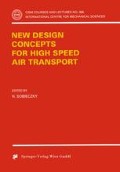Abstract
This paper will discuss examples of supersonic aerodynamic shape optimization as developed for Daimler-Benz Aerospace Airbus by Synaps, Inc.
First, we will introduce a general approach to aerodynamic shape design based on minimization of energy consumption during aircraft life while considering realistic constraints on lift, pitching and rolling moments and geometric dimensions. The analysis is performed using a potential code with real flow corrections and a decoupled boundary layer calculation. Finally, this method is applied to the design of the European Supersonic Civil Transport and the Oblique Flying Wing.
Access this chapter
Tax calculation will be finalised at checkout
Purchases are for personal use only
Preview
Unable to display preview. Download preview PDF.
References
Abbott, I., von Doenhoff, A. Theory of Wing Sections, Dover Publications, New York 1949.
Baals, D. D., Robins, A., Harris, R.V. Aerodynamic Design Integration of Supersonic Aircraft, AIAA 68–1018, 1968
Bore, C.L. Propulsion Streamtubes in Supersonic Flow and Supercritical Intake Cowl, Aeronautical J., September 1993.
Braunschädel, A. Erprobung Numerischer Aerodynamischer Verfahren für Überschallverkehrsflugzeuge an Verschiedenen Konfigurationen, Diplomarbeit Technische Hochschule Aachen, 1994.
Carlson, H. A Numerical Method For the Design of Camber Surfaces of Supersonic Wings With Arbitrary Planforms, NASA TND 2341, 1964
Carlson, H. W., Mack, R. J., Barger, R. L. Estimation of Attainable Leading-edge Thrust for Wings at Subsonic and Supersonic Speeds, NASA TP-1500, 1979.
Cosentino, G. M., Holst, T. L. Numerical Optimization Design of Advanced Transonic Wing Configurations, J. Aircraft 23 (3), 1986.
Dargel, G., Thiede, P. Viscous Transonic Airfoil Flow Simulation by an Efficient Viscous-inviscid Interaction Method, AIAA paper 87–0412, Jan. 1987.
Eminton, E., Lord, W. T. Note on the Numerical Evaluation of the Wave Drag of Smooth Slender Bodies Using Optimum Area Distributions for Minimum Wave Drag, J. Roy. Aero. Soc., Jan. 1956.
Eppler, R., Somers, D. A Computer Program for the Design and Analysis of Low-speed Airfoils, NASA TM 80210, 1980.
Greif, E. In-flight Measurement of Static Pressures and Boundary Layer State with Integrated Sensors, J. Aircraft 28 (5), May 1991.
Hicks, R., Van der Plaats, G., Murman, E. M., King, R. Airfoil Section Drag Reduction at Transonic Speeds by Numerical Optimization, SAE Paper 760–477, 1976.
Holst, T. Viscous Transonic Airfoil Workshop Compendium of Results, AIAA 87–1460, 1987.
Krämer, E., Gottmann, T. Berechnung des Strömungsfeldes eines Überschallflugzeugs mit Vorder-und Hinterkantenklappen im Transschall mit Hilfe des EUFLEX - Verfahrens, DASA—LME211—SPUB-531, Munich 1993.
Lee, K. D. Application of Computational Fluid Dynamics in Transonic Aerodynamic Design, AIAA paper 93–3481-CP, 1993.
Lomax, H. The Wave Drag of Arbitrary Configurations in Linearized Flow as Determined by Areas and Forces in Oblique Planes, Ames Aeronautical Laboratory, NACA RM A55 - A18, 1955.
Reneaux, J. Numerical Optimization Methods for Airfoil Design, Recherche Aerospatiale no. 1984 5, 1984.
Sobieczky, H. Progress in Inverse Design and Optimization in Aerodynamics, AGARD CP 463 Paper 1, (1989)
Torenbeek, E. Synthesis of Subsonic Airplane Design, Delft University Press, 1982.
Tucker, W.A. A Method for the Design of Sweptback Wings Warped to Produce Specified Flight Characteristics at Supersonic Speeds, NACA R 1226, 1956
Van der Velden, A. J. M. Aerodynamic Design and Synthesis of the Oblique Flying Wing Supersonic Transport, Ph.D. Thesis, Stanford University, Dept. Aero./Astro. SUDAAR 621, UMI Microfilm #DA9234183, June 1992.
Van der Velden, A. J. M. Multi-disciplinary SCT Design Optimization, AIAA paper 93–3931, 1993.
Van der Velden, A. J. M. Multi-point Optimization of Airfoils, Deutsche Aerospace Airbus Bericht EF-1979, Nov. 1993 (not published).
Van der Velden, A., J. M. Tools for Applied Engineering Optimization, AGARD R 803, Apr. 1994.
Van der Velden, A. J. M., Von Reith, D. Multi-Disciplinary SCT Design at Deutsche Aerospace Airbus, 7th European Aerospace Conference EAC ‘94. 25–27 October 1994 Toulouse.
Woodward, F. A. Analysis and Design of Supersonic Wing-body Combinations, Including Flow Properties in the Near-field, NASA CR-73106, 1967.
Author information
Authors and Affiliations
Editor information
Editors and Affiliations
Rights and permissions
Copyright information
© 1997 Springer-Verlag Wien
About this chapter
Cite this chapter
Van der Velden, A. (1997). Supersonic Aircraft Shape Optimization. In: Sobieczky, H. (eds) New Design Concepts for High Speed Air Transport. International Centre for Mechanical Sciences, vol 366. Springer, Vienna. https://doi.org/10.1007/978-3-7091-2658-5_16
Download citation
DOI: https://doi.org/10.1007/978-3-7091-2658-5_16
Publisher Name: Springer, Vienna
Print ISBN: 978-3-211-82815-1
Online ISBN: 978-3-7091-2658-5
eBook Packages: Springer Book Archive

